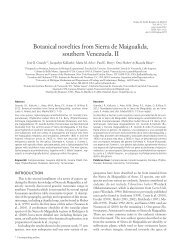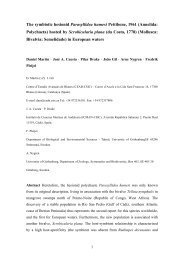FUNCTIONAL AND BIOACTIVE PROPERTIES OF COLLAGEN AND ...
FUNCTIONAL AND BIOACTIVE PROPERTIES OF COLLAGEN AND ...
FUNCTIONAL AND BIOACTIVE PROPERTIES OF COLLAGEN AND ...
Create successful ePaper yourself
Turn your PDF publications into a flip-book with our unique Google optimized e-Paper software.
Poultry by-products are also increasingly processed into collagen-based high-value products. Pepsin<br />
or ethylene diamine was used for extracting type I and type III collagens from chicken skins, with a<br />
yield (collagen content in the solid phase) of 38.9% for pepsin extraction and 25.1% for extraction<br />
with ethylene diamine (Cliche, Amiot, Avezard & Gariépy, 2003). A pepsin-aided process was<br />
proposed to extract type II collagen from chicken sternal cartilage, which is another important byproduct<br />
of the poultry processing industry, in order to eliminate the presence of immunogenic<br />
response-inducing telopeptides, while affecting only minimally collagen functional properties (Cao &<br />
Xu, 2008).<br />
3.- Methods for species differentiation<br />
Frequently, it may be necessary to differentiate between gelatins from different sources not only for<br />
safety and religious reasons, but because it has been reported that most gelatin-allergic patients<br />
develop allergic reactions to bovine and porcine gelatin, but do not react to fish gelatin (Sakaguchi et<br />
al., 2000). Despite labelling precautions, bovine and porcine gelatins pose a high degree of risk for<br />
sensitized patients because they are often present in commercial foods and food ingredients, due to<br />
cross-contamination during processing. Some studies have reported on differentiation between bovine<br />
and porcine gelatins based on amino acid analysis using principal component analysis (Nemati,<br />
Oveisi, Abdollahi & Sabzevari, 2004) or the pH drop method after calcium phosphate precipitation<br />
(Hidaka & Liu 2002). Nevertheless, more accurate methodologies have now been developed to trace<br />
the species origin of gelatin contained in commercial food products.<br />
The close similarity between collagen amino-acid sequences from different species makes their<br />
immunochemical differentiation difficult when using polyclonal antibodies against the whole<br />
molecule. Venien & Levieux (2005) reported on the successful production of bovine specific<br />
antibodies by immunization of rabbits with synthetic peptides mimicking a short putative speciesspecific<br />
sequence of the bovine alpha 1(I) chain. Using these antibodies, an indirect ELISA was<br />
developed to allow a quick and easy differentiation between bovine and porcine gelatins and for the<br />
sensitive quantitation of their mixtures. Similarly, two sandwich ELISA methods, based on antibodies<br />
from rabbits and goats immunized with bovine gelatin were found to be highly specific for bovine<br />
and porcine gelatin, but had little reactivity with fish gelatin (Doi, Watanabe, Shibata & Tanabe,<br />
2009).<br />
Zhang et al. (2009) proposed a new method for species differentiation using high performance liquid<br />
chromatography/tandem mass spectrometry (HPLC-MS/MS), based on detection and identification of<br />
specific marker peptides in tryptic-digested bovine and porcine gelatins, and found proline<br />
hydroxylation to be a key factor affecting peptide identification.<br />
Recently, a method based on the application of Fourier transform infrared spectroscopy (FTIR) in<br />
combination with attenuated total reflectance (ATR), principal component analysis and discriminant<br />
8

















